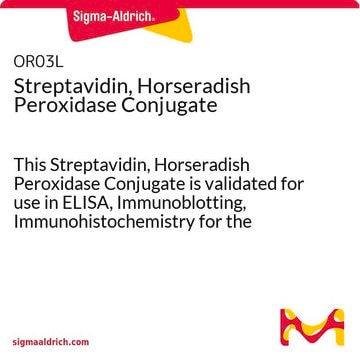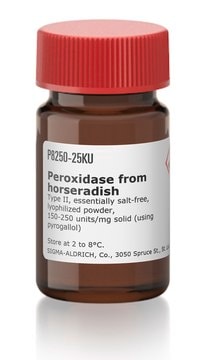11829696001
Roche
Peroxidase Labeling Kit
sufficient for 5 labeling reactions, kit of 1 (7 components), suitable for ELISA, suitable for immunohistochemistry
Synonym(s):
Peroxidase
About This Item
Recommended Products
usage
sufficient for 5 labeling reactions
Quality Level
specific activity
800 U/mg (800 U/mg protein at +25°C and pH 5.0 with ABTS and H2O2 as substrates.)
800 units/mg protein (At 25 °C and pH 5.0 with ABTS and H<sub>2</sub>O<sub>2</sub> as substrates.)
packaging
kit of 1 (7 components)
manufacturer/tradename
Roche
technique(s)
ELISA: suitable
immunoblotting: suitable
immunohistochemistry: suitable
storage temp.
2-8°C
Related Categories
General description
Specificity
Isoenzyme distribution: > 90% homogeneous isoenzyme C.
Assay Time: The procedure is developed for a reaction temperature of +25°C. At +25°C the reaction time should be 2 hours but it can be extended to 3 hours without influencing the results. Alternatively, the reaction can be carried out at +2 to +8°C with a reaction time of 18 hours up to 24 hours.
Application
- ELISA (enzyme-linked immunosorbent assay)
- immunohistochemistry
- immunoblotting
Features and Benefits
- Fast - the whole labeling procedure can be performed in one day
- Easy - only 5 simple working steps
- Complete - all necessary buffers and reagents are supplied with the kit
Packaging
- Peroxidase (activated)
- Sodium Carbonate/hydrogen Carbonate Buffer
- Sodium Borohydride (tablets)
- Triethanolamine Buffer
- Glycine Solution
- Dialysis Buffer
- Stabilizing Agent (includes BSA and Kathon CG)
Preparation Note
For best results, mark each solution with the appropriate number. Volumes indicated are sufficient to label a portion of 1.2 mg IgG.
Solution 1: Peroxidase (activated)
Reconstitute the lyophilizate of bottle 1 in 0.5 ml double-distilled water (peroxidase concentration = 16 mg/ml).
Solution 2: Sodium Carbonate/-hydrogencarbo-nate Buffer (100 mM, pH 9.8)
Equilibrate bottle 2 to 15 to 25 °C. Be sure that all buffer components are dissolved. Add 10 ml of bottle 2 to 90 ml double-distilled water, mix well.
Solution 3: Sodium Borohydride Solution (200 mM)
We recommend to wear gloves when working with sodium borohydride. Prepare the solution immediately prior to use and keep cold on ice. Add 1 tablet of bottle 3 to 130 ml cold, double-distilled water, mix well.
Solution 4: Triethanolamine Buffer (2 M, pH 8.0)
Bottle 4, ready-to-use. Equilibrate the bottle to 15 to 25 °C. Be sure that all buffer components are dissolved.
Solution 5: Glycine Solution (1 M, pH 7.0)
Reconstitute the lyophilizate of bottle 5 in 0.5 ml double-dist. water (glycine concentration = 1 M)
Solution 6: Dialysis Buffer (1x conc.)
Equilibrate bottle 6 to 15 to 25 °C. Be sure that all buffer components are dissolved. Add 30 ml of bottle 6 to 570 ml double-dist. water, mix well.
Solution 7: Stabilizing Agent
Bottle 7 is ready-to-use. Equilibrate the bottle to 15 to 25 °C.
Preparation of the immunoglobulin solution
The IgG concentration of the antibody solution should be approx. 4 mg/ml (3.8 to 4.2 mg/ml). This concentration is critical for the coupling and should hence be checked photometrically before every coupling and adjusted if necessary: 1 mg/ml = 1.40 at A280 nm and 1 cm path length. 0.3 ml of this solution are required for each labeling reaction.
Note: Do not use preservatives, such as sodium azide and stabilizers, such as albumin or detergents.
Lyophilized immunoglobulin, salt-free
Weigh 1.6 mg into a suitable vessel and dissolve in 0.4 ml solution 2. Check the concentration and pH and adjust, if necessary.
Immunoglobulin in buffer
- When immunoglobulin is dissolved in phosphate buffered saline (PBS) without additional proteins or preservatives: Adjust the pH to 9.8 with 1 M sodium carbonate buffer (bottle 2). If necessary, dilute with solution 2 to obtain an IgG concentration of 4 mg/ml.
- When the immunoglobulin is dissolved in a buffer with organic salts: Dialyse immunoglobulin with solution 2 and adjust the concentration to 4 mg/ml with solution 2.
Stability of IgG solution
These solutions should always be prepared immediately for use.
Storage conditions (working solution): Stability of solutions
- Solution 1 is stable for 3 months at 2 to 8 °C. The solution can be aliquoted and shock-frozen at -60° C or below, and then stored at -15 to -25° C; note that a loss ofactivity of 10 to 20% may be observed.
- Solutions 2, 5 and 6 are stable for one week at 2 to 8 °C, and for 6 months at -15 to -25 °C, when stored frozen in aliquots.
- Solution 3 should always be prepared immediately before use.
- Solution 4 and 7 are stable at 2 to 8 °C until the expiration date indicated on the kit.
Other Notes
Kit Components Only
- Peroxidase (activated)
- Sodium Carbonate/Hydrogen Carbonate Buffer
- Sodium Borohydride (tablets)
- Triethanolamine Buffer
- Glycine Solution
- Dialysis Buffer
- Stabilizing Agent (includes BSA and Kathon CG)
signalword
Danger
Hazard Classifications
Acute Tox. 3 - Eye Dam. 1 - Repr. 1B - Resp. Sens. 1 - Skin Corr. 1C - Skin Sens. 1 - Water-react 1 Oral
supp_hazards
Storage Class
4.3 - Hazardous materials which set free flammable gases upon contact with water
wgk_germany
WGK 2
flash_point_f
does not flashNot applicable
flash_point_c
does not flashNot applicable
Certificates of Analysis (COA)
Search for Certificates of Analysis (COA) by entering the products Lot/Batch Number. Lot and Batch Numbers can be found on a product’s label following the words ‘Lot’ or ‘Batch’.
Already Own This Product?
Find documentation for the products that you have recently purchased in the Document Library.
Customers Also Viewed
Our team of scientists has experience in all areas of research including Life Science, Material Science, Chemical Synthesis, Chromatography, Analytical and many others.
Contact Technical Service
















